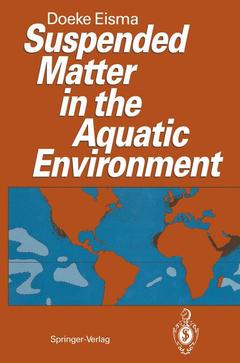Suspended Matter in the Aquatic Environment, Softcover reprint of the original 1st ed. 1993
Langue : Anglais
Auteur : Eisma Doeke

The purpose of this book is to give an introduction to the most important aspects of suspended matter in the aquatic environment: its origin and composition, the concentration distribution, transport and deposition, and the most important physical-chemical-bio logical process that affects suspended matter: flocculation. In Chap ter 1 the development of suspended matter observation and study throughout history is given, with the coming of a more modern approach during the 19th century and the first half of the 20th century, and the development of the present science of suspended matter after 1945. The sources of suspended matter in rivers, lakes, estuaries, and the sea are discussed in Chapter 2, which includes the supply of detrital particles as well as the formation of new particles in the water (organic matter, carbonate, opal). The concentration distribution of suspended matter in rivers, lakes, estuaries, tidal is discussed in Chapter 3, to which is areas, lagoons, and in the sea added a discussion on the sampling of suspended matter and on methods to determine its concentration. Particle composition is treated in Chapter 4, to which is added a section (4. 6) on the compositional analysis of suspended particles. Also included is a discussion on particle surface characteristics and the adsorption of elements and compounds onto particles.
1 Introduction.- 1.1 Suspended Matter Observations in History.- 1.2 Development of a More Quantitative Approach.- 1.3 Suspended Matter Transport Studies.- 2 Sources of Suspended Matter.- 2.1 Suspended Matter in Rivers.- 2.2 Suspended Matter in Lakes.- 2.3 Suspended Matter in Estuaries.- 2.4 Suspended Matter in the Sea.- 3 Concentration Distribution and Sampling of Suspended Matter.- 3.1 Concentration Distribution and Sampling of Suspended Matter.- 3.2 Sampling Suspended Matter and Determination of Suspended Matter Concentration.- 3.3 Sediment Traps.- 4 Particle Composition.- 4.1 Mineral Particles.- 4.2 Biogenic Particles.- 4.3 Adsorbed Elements and Compounds.- 4.4 Stable and Radioactive Isotopes.- 4.5 The Scavenging Process.- 4.6 Determination of Suspended Particle Composition.- 5 Transport of Suspended Matter.- 5.1 Turbulence.- 5.2 Transport of Suspended Matter.- 5.3 Initiation of Particle Motion (Scour, Erosion, Resuspension).- 5.4 Transport by Surface Waves.- 5.5 Particle Settling.- 5.6 Particle Deposition.- 5.7 Stratification.- 5.8 Autosuspension.- 6 Particle Size.- 6.1 Flocculation of Suspended Matter.- 6.2 Floc Density and Settling Velocity.- 6.3 Grain Size in Relation to Particle Size: Size Sorting.- 6.4 Measuring Particle Size.- 7 Transport Systems and Fluxes of Suspended Matter.- 7.1 In Rivers.- 7.2 In Lakes.- 7.3 Transport and Fluxes in Estuaries.- 7.4 Intertidal Areas.- 7.5 Fjords.- 7.6 The Continental Shelf.- 7.7 Suspended Matter in Canyons and Along the Continental Slope.- 7.8 Suspended Matter in the Ocean.
Date de parution : 12-2011
Ouvrage de 315 p.
15.5x23.5 cm
Thème de Suspended Matter in the Aquatic Environment :
© 2024 LAVOISIER S.A.S.


